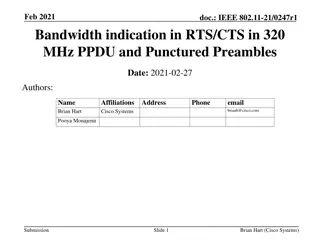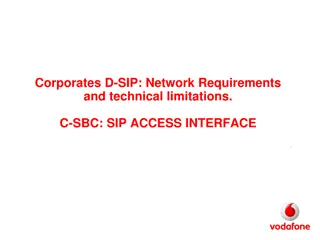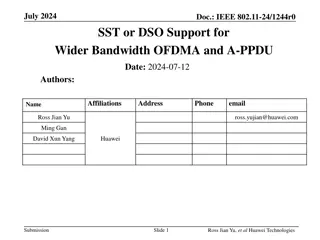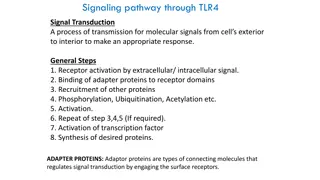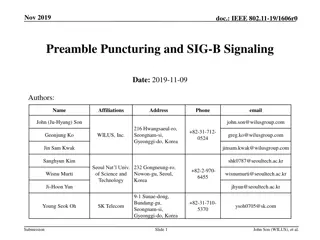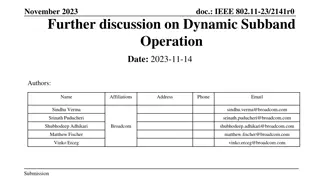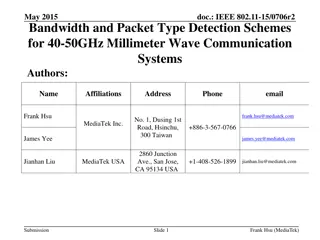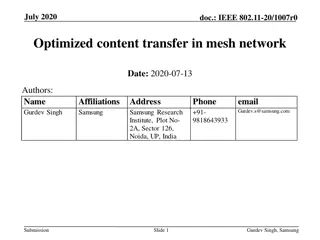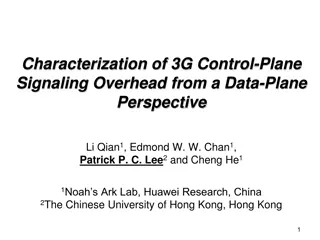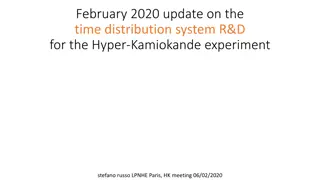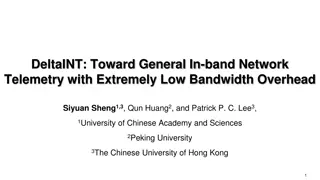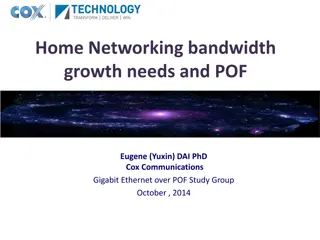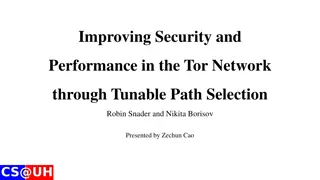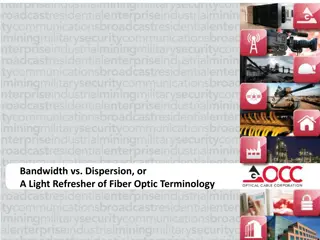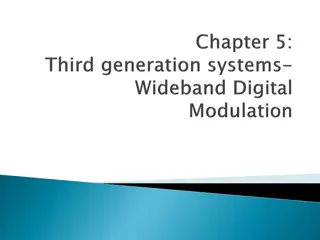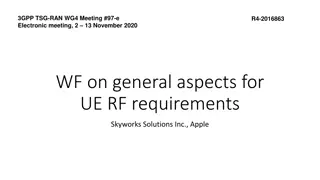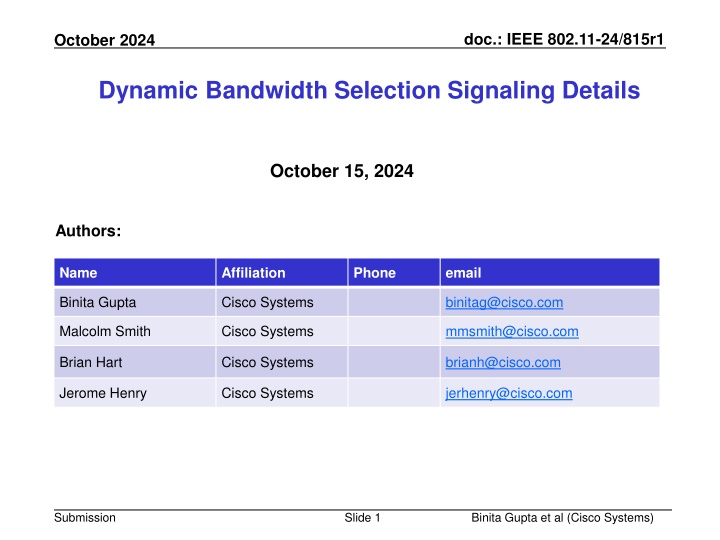
Dynamic Bandwidth Selection in IEEE 802.11-24/815r1
Explore the details of Dynamic Bandwidth Selection (DBS) in IEEE 802.11-24/815r1 for improved spectrum efficiency and network performance. Learn about RT-DBS operation modes, DBS coexistence with NPCA, and the steps involved in Long-term based Dynamic BW Selection.
Download Presentation

Please find below an Image/Link to download the presentation.
The content on the website is provided AS IS for your information and personal use only. It may not be sold, licensed, or shared on other websites without obtaining consent from the author. If you encounter any issues during the download, it is possible that the publisher has removed the file from their server.
You are allowed to download the files provided on this website for personal or commercial use, subject to the condition that they are used lawfully. All files are the property of their respective owners.
The content on the website is provided AS IS for your information and personal use only. It may not be sold, licensed, or shared on other websites without obtaining consent from the author.
E N D
Presentation Transcript
doc.: IEEE 802.11-24/815r1 October 2024 Dynamic Bandwidth Selection Signaling Details October 15, 2024 Authors: Name Affiliation Phone email Binita Gupta Cisco Systems binitag@cisco.com Malcolm Smith Cisco Systems mmsmith@cisco.com Brian Hart Cisco Systems brianh@cisco.com Jerome Henry Cisco Systems jerhenry@cisco.com Submission Slide 1 Binita Gupta et al (Cisco Systems)
doc.: IEEE 802.11-24/815r1 October 2024 Recap - Real Time Dynamic Bandwidth Selection (DBS) In [1] it was highlighted that 160 and higher MHz channels are unlikely to be deployed in enterprise networks Radio Resource Management (RRM, non real time) prefers WLAN stability and typically employs conservative frequency reuse (e.g. 10+), leading to mostly adoption of 40MHz (for 5GHz) and 40-80MHz (for 6 GHz) With MAPC, neighboring APs can coordinate & identify opportunities for BW expansion in real-time, e.g. from 40 to 160MHz expanded BW (E-BW) Exploiting variations in neighboring BSS load and interference conditions RT-DBS enables opportunistic use of wider BW in enterprise deployments, improving spectrum efficiency and network performance [1] proposed two modes of RT-DBS operation: Long-term based RT-DBS (e.g. over seconds) TXOP based RT-DBS Here we propose next level of details for Long-term based RT-DBS Submission Slide 2 Binita Gupta et al (Cisco Systems)
doc.: IEEE 802.11-24/815r1 October 2024 DBS Coexistence with NPCA Several presentations have proposed NPCA [2,3] and NPCA is in 11bn SFD [4] When BSS BW is dynamically expanded (to E-BW), NPCA operation can take E-BW into consideration (P20 remains unchanged with DBS) AP can announce a different NPCH within E-BW, if preferred based on channel conditions STAs that support DBS can switch to the NPCH in E-BW for NPCA Non-DBS STAs, would temporarily disable NPCA if NPCH is outside BSS operating BW Even with DBS, AP can keep same NPCH as before BW expansion, based on the mix of DBS and non-DBS STAs and/or channel conditions. With DBS E-BW, similar NPCA behavior would apply NPCA Operation with DBS E-BW DBS Expanded BW = 160 MHz NPCA Operation I C F I C R A C K DL/ UL S80 OFDMA PPDU NPCH in E-BW Operating BW = 80 MHz I C F I C R A C K S40 S40 DL/ UL OFDMA PPDU NPCH S20 S20 OBSS PPDU (40 MHz) OBSS PPDU (40 MHz) P20 P20 PCH PCH Submission Slide 3 Binita Gupta et al (Cisco Systems)
doc.: IEEE 802.11-24/815r1 October 2024 Long-term based Dynamic BW Selection Steps involved: Step 1: Multi-AP coordination to identify DBS opportunity Step 2: Dynamic Bandwidth Selection signaling Step 3: Operation with Dynamic Bandwidth Selection Step 4: Termination of Dynamic Bandwidth Selection Submission Slide 4 Binita Gupta et al (Cisco Systems)
doc.: IEEE 802.11-24/815r1 October 2024 Step 1 MAPC to identify DBS opportunity Neighboring APs coordinate to determine BW expansion opportunity BSS load/channel usage shared between neighboring APs Per-subchannel OBSS CCI can be estimated by APs (e.g. using a scan radio) Based on neighboring APs channel load, CCI measurements and other factors, network/AP determines BW expansion for an AP (e.g. for AP with higher load) Puncturing can be used in E-BW to puncture out BW of some neighboring AP s Network determines start time for dynamic BW expansion (e.g. x TUs in future) and expected duration for E-BW usage To simplify scope, DBS coordination messaging between APs can be exchanged over-the-DS (no need to define OTA signalling) Since primary use case is for APs in the same management domain DBS E-BW = 160 MHz AP2 (40 MHz) AP1 (40 MHz) DBS MAPC AP3 (40 MHz) AP4 (40 MHz) Submission Slide 5 Binita Gupta et al (Cisco Systems)
doc.: IEEE 802.11-24/815r1 October 2024 Step 2 Dynamic BW Selection signaling (1) BW expansion via legacy (E)CSA mechanisms is not a good option Many STAs respond to (E)CSA by roaming away and then roam back. Causing roaming impact to legacy STAs due to DBS is not acceptable Some legacy STAs will not associate with an AP that supports (E)CSA (E)CSA is designed for use with non-real time RRM, not for real-time changes Using (E)CSA to announce BW changes, could cause legacy interop issues: (E)CSA would change BW for all STAs, including legacy STAs, those STAs are not tested for frequent BW change may result in field interop issues (E)CSA is used for changing primary channel, which is not the case for DBS, where P20 remains same and only BW changes - this again may cause field interop issues. Changing BSS operating BW dynamically in BSS operation element or using OMN is not a good option either Legacy STAs are not tested for such freq BW changes may cause interop issues STAs in PS may not receive Beacons and/or OMN and can miss BW changes Hence, we propose to define a new signaling mechanism to notify UHR STAs of dynamic BW changes in advance this avoids any undesired impact on pre-UHR STAs Submission Slide 6 Binita Gupta et al (Cisco Systems)
doc.: IEEE 802.11-24/815r1 October 2024 Step 2 Dynamic BW Selection signaling (2) AP and STA both indicate capability support for DBS and Max DBS BW supported in management frame(s) Note: BSS Operating BW is signaled separately and AP s P20 remains unchanged AP and STA also indicate their BW Switching delay for Max DBS BW(s) DBS parameters signaling by STAs A non-AP STA can dynamically enable/disable DBS support STA can signal its DBS support, Max DBS BW, DBS BW Switch Delay to AP e.g. in (Re)Assoc Request or in another management frame for DBS DBW BW switch delay accounts for STA s delay for expanding the BW At times, STA may have constraint to expand to Max DBS BW, e.g. due to power save. STA can dynamically signal an updated/lower Max DBS BW. Later, when no longer constrained, it can signal its original/higher Max DBS BW. signaled through a DBS mgmt. frame, or in-band in an A-Control field AP uses latest Max DBS BW indicated by associated STAs to determine parameters for DBS announcement Submission Slide 7 Binita Gupta et al (Cisco Systems)
doc.: IEEE 802.11-24/815r1 October 2024 Step 2: Dynamic BW Selection signaling (3) Dynamic BW Selection announcement by AP We propose to define a mechanism for Dynamic Bandwidth Selection Announcement (DBSA) by AP in Beacons and Probe Response AP determines DBS expanded-BW (E-BW) based on the set of associated STAs that support DBS, and their Max DBS BW supported e.g. if STAs support Max DBS BWs of 80 & 160MHz, AP may select E-BW of 160MHz AP announces DBS E-BW within a DBSA element that includes: BW Indication fields - DBS E-BW, Disabled Subchannel bitmap DBS start time (e.g. in units of TUs, # of TBTTs, or a future TSF time) DBS duration (e.g. in units of TUs) Puncturing can be used in DBS E-BW To signal odd E-BWs e.g. 120MHz signaled as 160MHz with 40MHz punctured To puncture out operating BW of a neighboring BSS DBSA is advertised in advance in Beacons to notify STAs of upcoming E-BW DBSA is also advertised for the duration when DBS E-BW is active Submission Slide 8 Binita Gupta et al (Cisco Systems)
doc.: IEEE 802.11-24/815r1 October 2024 Step 3 Operation with Dynamic BW Selection (1) Once a DBS E-BW becomes active (at DBS start time), AP and supporting STAs can use expanded BW for their transmissions AP and STA select expanded BW (for that STA) based on STA s Max DBS BW and DBS E-BW announcement in the Beacon STA s E-BW = min (STA s Max DBS BW, E-BW in DBSA) see table below AP can use STA s E-BW in its DL/UL OFDMA to that STA (along with other DBS and non-DBS STAs) A DBS supporting STA can operate with the STA s E-BW for its UL EDCA BSS Operating BW STA Max DBS BW E-BW in DBS Announcement Selected E-BW for STA 40 MHz 80 MHz 80 MHz 80 MHz 40 MHz 160 MHz 160 MHz 160 MHz 40 MHz 160 MHz 80 MHz 80 MHz 40 MHz 80 MHz 160 MHz 80 MHz Submission Slide 9 Binita Gupta et al (Cisco Systems)
doc.: IEEE 802.11-24/815r1 October 2024 Step 3 Operation with Dynamic BW Selection (2) During an active DBS duration, a STA may have a use case to signal a change in its Max DBS BW e.g. from 160 to 80 MHz due to power save signaled in-band using A-Control or via a management frame Both AP and STA would use the updated Max DBS BW to select a revised STA s E-BW for use in subsequent TXOPs with the DBS duration Ex: If for a STA Max DBS BW changes:160 ->80, STA & AP operate with 80MHz for that STA BW Switching delay of STA and AP needs to be accounted by both peers at the start and end of DBS duration DBS Operation STAs x, y, z 160 STAs a, b, c 80 40 AP and STAs operating at 40 MHz Non-DBS STAs continue to operate at 40 MHz AP and STAs operating at 40 MHz DBSA in Beacon DBSA in Beacon DBS Start time (Ts) - DBS E-BW ends - AP & STAs switch back to BSS operating BW DBS operating parameters exchange between AP and STAs MAPC for DBS BW expansion (over-the-DS) DBS Duration DBS E-BW set to 160MHz AP and STAs operating at expended BW: 80 MHz for STAs a, b, c 160 MHz for STAs x, y, z Submission Slide 10 Binita Gupta et al (Cisco Systems)
doc.: IEEE 802.11-24/815r1 October 2024 Step 4 Termination of Dynamic BW Selection When the DBS duration expires for a DBS E-BW, DBS operation terminates AP and DBS supporting STAs go back to using the BSS operating BW Alternatively, AP may also extend or shorten the DBS duration in DBS announcement, based on real time measurements (BSS load, CCI) from neighboring APs. All DBS announcement related changes in Beacon must be considered critical updates and get reflected in BSS Parameters Change Count (BPCC) Submission Slide 11 Binita Gupta et al (Cisco Systems)
doc.: IEEE 802.11-24/815r1 October 2024 Conclusion Most enterprise deployments are stuck at 40 MHz today, despite wider BWs being available Real-time DBS enables enterprise deployments to opportunistically make use of wider BWs, while still honoring RRM goal of WLAN stability We proposed procedure and signaling to support Long-term based DBS for UHR STAs: Dynamic bandwidth expansion opportunity can be realized using MAPC for DBS (OTDS to simplify the scope) DBS E-BW announced in advance by AP in Beacons, Probe Response Once DBS E-BW is active, AP and supporting STAs select E-BW based on STA s Max DBS BW, and can operate with selected E-BW for UL/DL PPDU exchange Once DBS duration ends, DBS is terminated and AP/STAs go back to using BSS operating BW Submission Slide 12 Binita Gupta et al (Cisco Systems)
doc.: IEEE 802.11-24/815r1 October 2024 Straw Poll 1 Do you agree to define in 11bn a mechanism for dynamic bandwidth selection (DBS) that enables expanding operating bandwidth for a time duration for UHR STAs that support DBS operation? Submission Slide 13 Binita Gupta et al (Cisco Systems)
doc.: IEEE 802.11-24/815r1 October 2024 References [1] 11-24/0088 Maximizing channel bandwidth in dense AP deployments [2] 11-23-1891 Nonprimary channel access - follow up [3] 11-23-2005 Non-primary channel access (NPCA) [4] 11-24/0209 Specification Framework for TGbn Submission Slide 14 Binita Gupta et al (Cisco Systems)


